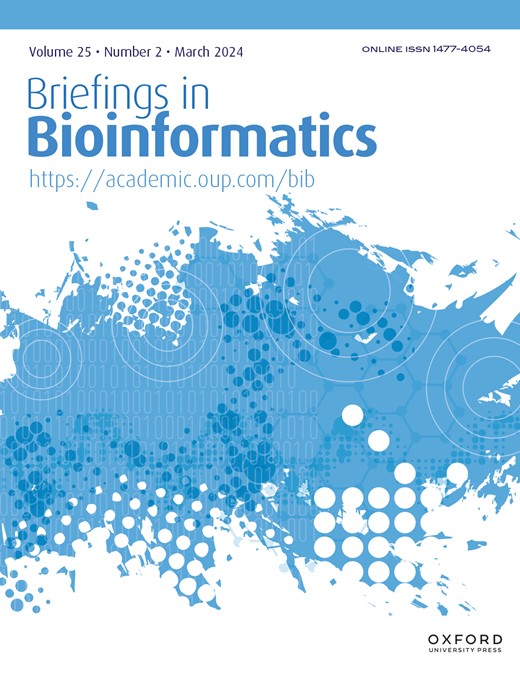Benchmarking mapping algorithms for cell-type annotating in mouse brain by integrating single-nucleus RNA-seq and Stereo-seq data
IF 6.8
2区 生物学
Q1 BIOCHEMICAL RESEARCH METHODS
引用次数: 0
Abstract
Limited gene capture efficiency and spot size of spatial transcriptome (ST) data pose significant challenges in cell-type characterization. The heterogeneity and complexity of cell composition in the mammalian brain make it more challenging to accurately annotate ST data from brain. Many algorithms attempt to characterize subtypes of neuron by integrating ST data with single-nucleus RNA sequencing (snRNA-seq) or single-cell RNA sequencing. However, assessing the accuracy of these algorithms on Stereo-seq ST data remains unresolved. Here, we benchmarked 9 mapping algorithms using 10 ST datasets from four mouse brain regions in two different resolutions and 24 pseudo-ST datasets from snRNA-seq. Both actual ST data and pseudo-ST data were mapped using snRNA-seq datasets from the corresponding brain regions as reference data. After comparing the performance across different areas and resolutions of the mouse brain, we have reached the conclusion that both robust cell-type decomposition and SpatialDWLS demonstrated superior robustness and accuracy in cell-type annotation. Testing with publicly available snRNA-seq data from another sequencing platform in the cortex region further validated our conclusions. Altogether, we developed a workflow for assessing suitability of mapping algorithm that fits for ST datasets, which can improve the efficiency and accuracy of spatial data annotation.通过整合单核 RNA-seq 和 Stereo-seq 数据,为小鼠大脑中细胞类型注释的绘图算法制定基准
空间转录组(ST)数据有限的基因捕获效率和斑点大小给细胞类型鉴定带来了巨大挑战。哺乳动物大脑中细胞组成的异质性和复杂性使准确注释大脑中的 ST 数据更具挑战性。许多算法试图通过整合 ST 数据与单核 RNA 测序(snRNA-seq)或单细胞 RNA 测序来表征神经元亚型。然而,评估这些算法在立体测序 ST 数据上的准确性仍是一个悬而未决的问题。在这里,我们使用来自四个小鼠脑区的两种不同分辨率的 10 个 ST 数据集和来自 snRNA-seq 的 24 个伪 ST 数据集对 9 种绘图算法进行了基准测试。实际 ST 数据和伪 ST 数据都是以相应脑区的 snRNA-seq 数据集为参考数据绘制的。在比较了小鼠大脑不同区域和分辨率的性能后,我们得出结论:稳健细胞类型分解和空间DWLS在细胞类型注释方面都表现出了卓越的稳健性和准确性。用另一个测序平台在大脑皮层区域公开提供的 snRNA-seq 数据进行的测试进一步验证了我们的结论。总之,我们开发了一种评估适合 ST 数据集的绘图算法的工作流程,它可以提高空间数据注释的效率和准确性。
本文章由计算机程序翻译,如有差异,请以英文原文为准。
求助全文
约1分钟内获得全文
求助全文
来源期刊

Briefings in bioinformatics
生物-生化研究方法
CiteScore
13.20
自引率
13.70%
发文量
549
审稿时长
6 months
期刊介绍:
Briefings in Bioinformatics is an international journal serving as a platform for researchers and educators in the life sciences. It also appeals to mathematicians, statisticians, and computer scientists applying their expertise to biological challenges. The journal focuses on reviews tailored for users of databases and analytical tools in contemporary genetics, molecular and systems biology. It stands out by offering practical assistance and guidance to non-specialists in computerized methodologies. Covering a wide range from introductory concepts to specific protocols and analyses, the papers address bacterial, plant, fungal, animal, and human data.
The journal's detailed subject areas include genetic studies of phenotypes and genotypes, mapping, DNA sequencing, expression profiling, gene expression studies, microarrays, alignment methods, protein profiles and HMMs, lipids, metabolic and signaling pathways, structure determination and function prediction, phylogenetic studies, and education and training.
 求助内容:
求助内容: 应助结果提醒方式:
应助结果提醒方式:


